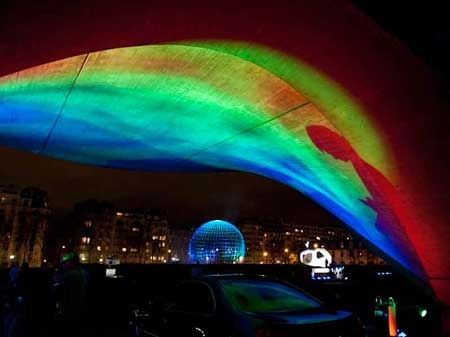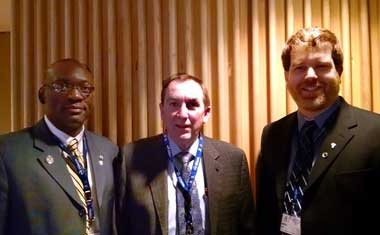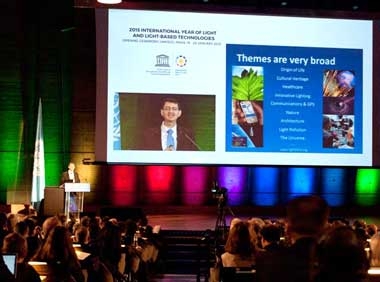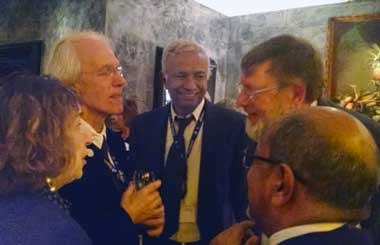
As someone who has spent over two decades studying and researching optics, I was excited to learn that 2015 had been designated the International Year of Light. With an impressive list of sponsors, including AIP and three Member Societies (APS, OSA, and AAS), it was clear that the year holds great potential. Kicking the year off right, I had the opportunity to attend the opening ceremony held at UNESCO headquarters in Paris, France, on January 19-20.
A celebration of light in the City of Light was certainly one to remember. Located near the shimmering Eiffel Tower, both the UNESCO

globe and the building itself were lit in bright colors for the event. Ambassadors and other dignitaries from around the world discussed political and cultural implications of light. Leading scientists, including five Nobel laureates, highlighted major advances that have shaped our modern world. Speakers covered the spectrum from France Cordova, Director of the National Science Foundation, to Gianfranco Cardinal Ravasi, President of the Pontifical Council for Culture. There were art exhibits, as well as cultural, historical, and educational displays honoring the work of Ibn Al-Haytham, an 11th century scientist who wrote the first major text on optics. We were even treated to the musical mastery of Joshua Bell, who performed pieces from the score of the upcoming film Einstein's Light. If these two days would be any indication, the International Year of Light and Light-based Technologies was going to make quite a splash.


Heading into the event, however, I held one major question—what would the positive outcomes of the International Year of Light truly be? While celebrating achievements and increasing public awareness are worthwhile, if that is all that would be accomplished by such a major international collaboration, I for one would be disappointed. At the same time, it was also unclear to me before heading to Paris how AIP or SPS could meaningfully participate in the International Year of Light, what goals we should set, and how this would fit within our mission.
Almost as soon as the opening ceremony began, some powerful answers to these questions began to arise. John Dudley, Chairman of the IYL 2015 Steering Committee, gave a clear call for our community to put our combined efforts into bettering the world. While this could have been left as a grandiose and vague ideal, he and several of the speakers that followed

defined some specific projects towards which we could work. Some of these included efforts to bring low-cost, safe, and efficient lighting to underdeveloped areas of the world; providing glasses to those who could not otherwise afford them; and using solar power to bring modern amenities to remote areas. Perhaps the best measure of the success of the International Year of Light will be any momentum gained by efforts such as these.
Every society or organization taking part in the International Year of Light must decide how their resources and efforts should be used, and what goals they wish to set. As SPS and Sigma Pi Sigma encourage service and outreach among our members, I would like to see many of our chapters get involved with projects that will help society while simultaneously spreading understanding and appreciation of how light affects so many aspects of our lives. In a time when public opinion of science is seemingly deteriorating, a concerted effort by physical scientists to help those most in need could serve as a much needed reminder to the world of the value of science.

I left Paris having made some wonderful connections, with glistening lights, sounds of the violin, and magical liquid nitrogen demonstrations of Nobel laureate Bill Phillips all taking up a lasting place in my mind. Most importantly, I returned with newfound hope that the physical sciences community would make a lasting, positive impact on the world through the International Year of Light.
